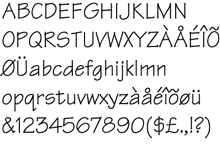 I met with Bob Smith, VP of product marketing for Magma, earlier this week, over a glass of wine and a lunch in a nice French bistro, to talk about the new product that they are introducing today. They are introducing a completely new from-the-ground-up timing engine called Tekton. I happen to know that Tekton is also typeface (font) designed by David Siegel, one of the first designers to take the web seriously.
I met with Bob Smith, VP of product marketing for Magma, earlier this week, over a glass of wine and a lunch in a nice French bistro, to talk about the new product that they are introducing today. They are introducing a completely new from-the-ground-up timing engine called Tekton. I happen to know that Tekton is also typeface (font) designed by David Siegel, one of the first designers to take the web seriously.
Magma have kept this development insulated from their general turmoil over the last couple of years. A year ago Magma seemed like it was coughing up blood and might not recover. Now they are clearly back. Rajeev apparently asked lots of CEOs of other companies how to cope with the downturn. “Slash R&D until the recovery comes and milk the existing products.” I’m not sure that ever works in EDA where the next process is coming down the track anyway, and Rajeev wisely ignored the advice, if anything doubling down on R&D since the stock market couldn’t punish him any more anyway.
It is always interesting watching established EDA companies bring completely new products to market. Far fewer of them are successful than you would expect. I think this is primarily due to the risk-averseness of their sales forces who make most of their money re-selling the same tools as last time and don’t want to risk delaying the renewal by introducing untried new products into the mix. This makes it impossible to mature the product and means it will die on the vine. In fact the only completely new products that I can think of that you would call successful are Calibre from Mentor, FineSim from Magma and, perhaps, PrimeTime from Synopsys (although they cheated there by buying Viewlogic and then shutting down Motive, the then market leader). All other products were either developed when the company was a startup (most notably Design Compiler and Magma’s original BlastFusion), came through acquisition, or were/are only marginally successful.
PrimeTime is now about 15 years old and so is perhaps vulnerable. Its basic architecture seems to make it hard to keep its performance in the top rank. Back then a full analysis was about 1 million instances and four process corners. Now a full analysis is about 50-100 million instances and 400 process ‘corners.’ The only way to do this with PrimeTime is to set up a huge farm and run lots of jobs in parallel on dozens of licenses. For example, one run of just 1.3M cells in 3 modes with 9 process corners (so 27 scenarios) required 27 machines and 65 minutes to do the analysis.
Tekton can apparently (and remember I was having lunch with the marketing guy not a hands-on user) do everything on a single 4 CPU machine in less than 30 minutes, and do a crosstalk analysis on the side. If these sorts of numbers hold up across the board, and if the correlation with PrimeTime (still the signoff standard) is nearly perfect then this will be an interesting battle to watch. Even though the product is only just being announced, Magma have already closed some customers and have several other high-profile evaluations in progress.
John Cooley managed to find some rumors about Tekton, including the product name, and correctly surmised that Magma would announce it at Music, their users conference, taking place this week.
Going forward, of course, Magma will be integrating the Tekton timing engine into their other timing-driven tools, such as Talus, to replace the older engine. This should speed up their other tools and also keep them on the capacity ramp necessary to handle sub 30nm designs.
The takeaway is that Tekton can time any design on a single machine in under an hour with just a single license. I think PrimeTime does over $100M in business so there is plenty of upside available for Magma to steal if the technology is as good as described. Let the battle begin.
